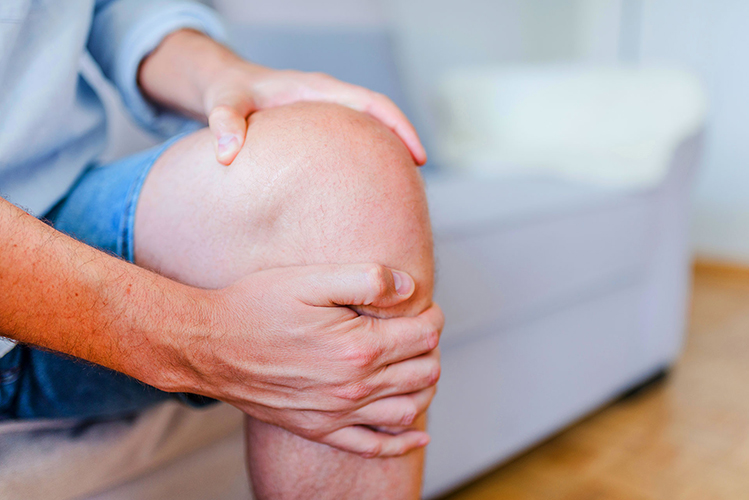
Knee Pain

What Is Knee Pain?
Knee pain refers to discomfort, swelling, or stiffness in or around the knee joint, a vital joint that supports weight-bearing and movement. This common issue can arise from injuries, overuse, or underlying medical conditions and may range from mild to severe, affecting activities such as walking, climbing stairs, or bending.
What Causes Knee Pain?
Knee pain can result from a variety of factors, including:
- Injuries:
- Ligament injuries: Such as ACL (anterior cruciate ligament) or MCL (medial collateral ligament) tears.
- Meniscus tears: Damage to the cartilage that cushions the knee.
- Fractures: Broken bones in the knee joint, often due to trauma.
- Patellar dislocation: When the kneecap slips out of its groove.
- Overuse Conditions:
- Tendinitis: Inflammation of the tendons, such as in jumper’s knee.
- Bursitis: Swelling of the fluid-filled sacs (bursae) that reduce friction in the joint.
- Arthritis:
- Osteoarthritis: Wear-and-tear damage to the cartilage in the knee.
- Rheumatoid arthritis: An autoimmune condition causing joint inflammation.
- Gout: A type of arthritis caused by uric acid crystal buildup.
- Structural Issues:
- Misalignment of the knee or surrounding bones.
- Weak or imbalanced muscles around the joint.
- Other Causes:
- Infections or inflammatory diseases affecting the knee joint.
What Are the Symptoms of Knee Pain?
The symptoms of knee pain can vary depending on its cause. Common symptoms include:
- Pain or tenderness in the knee, which may worsen with activity.
- Swelling, redness, or warmth around the joint.
- Stiffness or difficulty bending and straightening the knee.
- Instability or a feeling that the knee might “give out.”
- Popping, clicking, or grinding sounds during movement.
- Inability to bear weight on the affected leg.
If knee pain is severe, persistent, or accompanied by other symptoms like fever or deformity, medical attention is recommended.
How Is Knee Pain Diagnosed?
Diagnosing knee pain involves a thorough evaluation, which may include:
- Medical history: Your healthcare provider will ask about your symptoms, activities, and any previous injuries or conditions.
- Physical examination: They’ll assess your knee’s range of motion, strength, stability, and areas of tenderness.
- Imaging tests:
- X-rays to detect fractures or arthritis.
- MRIs to evaluate soft tissues like ligaments and cartilage.
- Ultrasounds to assess fluid buildup or tendon issues.
- Lab tests: Blood tests or joint fluid analysis may help diagnose conditions like gout or infections.
What Are the Treatment Options for Knee Pain?
Treatment for knee pain depends on its cause and severity. Common options include:
- Conservative Treatments:
- Resting the knee and avoiding activities that worsen pain.
- Applying ice packs to reduce swelling and inflammation.
- Using over-the-counter pain relievers like ibuprofen or acetaminophen.
- Wearing knee braces or compression sleeves for support.
- Physical Therapy:
- Strengthening and flexibility exercises to improve joint stability.
- Gait and posture correction to reduce strain on the knee.
- Injections:
- Corticosteroid or biologic injections to reduce inflammation.
- Hyaluronic acid injections to lubricate the joint and improve mobility.
- The Coolief® Radiofrequency Procedure
- Surgical Options:
- Arthroscopic surgery for ligament or meniscus repairs.
- Partial or total knee replacement for severe arthritis or irreparable damage.
- Lifestyle Modifications:
- Weight management to reduce stress on the knee joint.
- Regular exercise to strengthen surrounding muscles and improve joint health.
When Should You See a Doctor for Knee Pain?
Seek medical attention if:
- The pain persists for more than a few weeks despite home care.
- The knee appears swollen, red, or deformed.
- You experience severe pain or instability while walking.
- There is difficulty bearing weight on the affected leg.
- You notice additional symptoms, such as fever or numbness.
Take the First Step Toward Relief
Knee pain can limit your mobility and impact your daily life, but effective treatments are available. If you’re experiencing persistent discomfort or other concerning symptoms, consult a healthcare provider for a comprehensive evaluation and personalized care plan. Don’t let knee pain slow you down—take the first step toward recovery and better joint health today!
